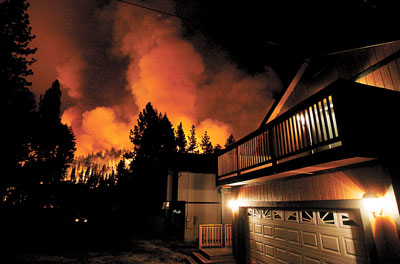Blaze devastates resort area

MEYERS, Calif. — Residents of Lake Tahoe’s south shore huddled beneath a smoke-filled sky Monday after fleeing a forest fire that destroyed more than 225 homes and outbuildings and clouded the lake’s clear water with falling ash.
Light winds Monday gave firefighters a leg up on the blaze, and by late afternoon, it was 40 percent contained, fire officials said. The U.S. Forest Service expects full containment of the blaze by Sunday, authorities said.
About 1,000 people have evacuated their homes in the popular resort area along the California-Nevada border while as many as 500 other houses remained threatened, authorities said. But with the level of containment, authorities said the threat against many of the homes has eased.
Some residents whose houses were moderately damaged will be allowed to return home this morning, the El Dorado County Sheriff’s Department said. By Thursday, authorities plan to start escorting residents to homes that were destroyed.
Many hotels offered free rooms as locals clung to one bit of good news: Despite the destruction, no injuries were reported.
"All the memories are gone," said Matt Laster, a legal assistant forced to flee his rented home of five years with his wife, two children and cat. He showed up at a recreation center looking for clothes and a sleeping bag.
State officials declared a state of emergency, meaning California would cover all costs in fighting the fire, which was under investigation but thought to be caused by human activity.
"This is a very difficult day for people in Tahoe and for those of us who know and love that place," said Lt. Gov. John Garamendi, who signed the emergency declaration because Gov. Arnold Schwarzenegger was traveling in Europe. The governor was receiving briefings by phone but had no plans to return early, his office said.
The blaze, dubbed the Angora Fire, had scorched almost 2,500 acres, nearly 4 square miles, officials said.
"This is far and above the biggest disaster that has happened in this community, I don’t know, probably in forever," El Dorado County Sheriff’s Lt. Kevin House said.
Firefighters launched an aggressive attack, hoping to bring the blaze under control ahead of high winds and low humidity forecast for the middle of the week. Dozens took up defensive positions around South Lake Tahoe High School as flames came within a quarter mile of the 1,500-student school.
"We have a window right now where we’re really trying to aggressively attack this fire," said Daniel Berlant, a spokesman for the California Department of Forestry and Fire Protection in Sacramento.
More than 700 firefighters were on hand, but plans to send up airborne tankers and helicopters to drop water and retardant over the wooded, parched terrain were delayed because of low visibility from the thick smoke. A pair of helicopters loaded with water finally reached the scene in the middle of the afternoon.
House said authorities had no reports of missing persons, but "the truth is we haven’t really been able to get in there and see."
A layer of black, mushy ash lapped along boat docks in the lake, raising fears the fire could have disastrous long-term economic consequences for a community dependent on the lake’s recreational tourism.
The National Weather Service issued a dense smoke advisory warning people from South Lake Tahoe to Carson City that heavy ash was making it difficult to see and breathe.
The fire began Sunday afternoon on a ridge separating the resort community of South Lake Tahoe from Fallen Leaf Lake, a recreation area where a U.S. Forest Service campground was evacuated.
By early afternoon Monday, 173 homes had been lost to flames, and many others were damaged, with dozens of outbuildings, authorities said. All that remained of entire neighborhoods in Meyers were the smoldering silhouettes of stone and concrete chimneys.
In other areas, the fire seemed to skip some homes, but downed power lines, trees and debris made clear that life would not return to normal anytime soon, even for those whose homes were spared.
The burned neighborhoods were a hodgepodge of million-dollar vacation homes, cabins and modest houses strung along the east side of the ridge. At least three members of the local fire department were thought to have lost their homes.
Steve Yingling, sports editor for the Tahoe Tribune newspaper, had little hope that his house survived. He was leaving for work Sunday afternoon when he heard the sirens.
"I looked back and saw the huge plume of smoke," he said Monday. "That’s when I really started to get scared because I know the danger alert that we’ve had in this area. Especially this year with the mild winter that we had."
State and federal fire officials had warned of an active wildfire season in the Sierra Nevada after an unusually dry winter. The annual May 1 snow survey found the Tahoe-area snowpack at 29 percent of normal levels, the lowest since 1988.
Fire restrictions have been in effect in the Tahoe National Forest since June 11. The No. 1 cause of blazes in the area is abandoned campfires, the U.S. Forest Service has said.
Residents barred from returning to the fire-damaged area jammed the lobby of Lake Tahoe Community College in South Lake Tahoe, hoping to get word from authorities on whether their homes were still standing. Some left in tears; others were thankful to have escaped the worst.
Cathy Martin of South Lake Tahoe e-mailed her son, a Marine serving in Iraq, to tell him about the fire.
"We’re very lucky that we are safe," said Martin, whose home was not damaged. "But I’m telling you this is awful for this community."
Firefighters were aided Monday by winds slowing to 12 mph after gusting to about 35 mph the day before.
"It was a good time to be charging in there and making some progress," U.S. Forest Service spokesman Rex Norman said. "But that could change if the winds change."